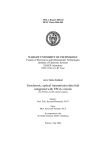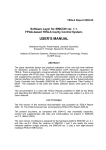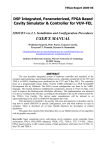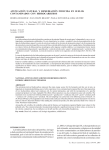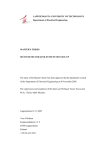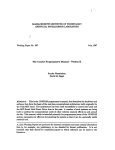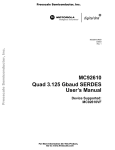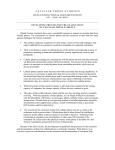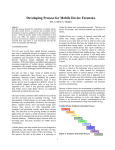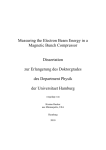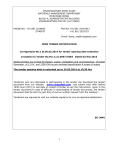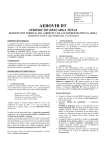Download DOOCS environment for FPGA-based cavity control system and
Transcript
TESLA Report 2005-13 DOOCS environment for FPGA-based cavity control system and control algorithms development Piotr Pucyk, Waldemar Koprek, Paweł Kaleta, Jarosław Szewiński, Krzysztof T. Poźniak, Tomasz Czarski, Ryszard S.Romaniuk Warsaw ELHEP Group Institute of Electronic Systems (ISE), Warsaw University of Technology, Nowowiejska 15/19, 00-665 Warsaw, Poland [email protected] ABSTRACT The paper describes the concept and realization of the DOOCS control software for FPGAbased TESLA cavity controller and simulator (SIMCON). It bases on universal software components, created for laboratory purposes and used in MATLAB based control environment. These modules have been recently adapted to the DOOCS environment to ensure a unified software to hardware communication model. The presented solution can be also used as a general platform for control algorithms development. The proposed interfaces between MATLAB and DOOCS modules allow to check the developed algorithm in the operation environment before implementation in the FPGA. As the examples two systems have been presented. Keywords: Distributed Object Oriented Control System, DOOCS, cavity simulator, cavity controller, SIMCON, Matlab, FPGA, VHDL, LLRF control system, control software environment, DOOCS specifics for FPGA systems Corresponding author: [email protected] 1 DOOCS environment for FPGA-based cavity control system and control algorithms development CONTENTS ABSTRACT ......................................................................................................... 1 1. INTRODUCTION ........................................................................................ 3 2. ALGORITHMS DEVELOPMENT PROCESS ........................................ 3 3. MATLAB-BASED CONTROL ENVIRONMENT .................................. 4 4. DOOCS-BASED CONTROL ENVIRONMENT...................................... 5 5. INTERFACES AND MODULES ............................................................... 6 5.1 MATLAB-DOOCS INTERFACE. .................................................... 7 5.2 DOOCS-HARDWARE INTERFACE. ............................................. 9 6. DOOCS-IMPLEMENTATION .................................................................. 9 6.1 DATA TYPES.................................................................................... 9 6.2 LIBRARIES..................................................................................... 11 6.3 SERVER........................................................................................... 12 7. APPLICATION – SIMULATOR AND CONTROLLER ...................... 13 8. SUMMARY................................................................................................. 17 9. ACKNOWLEDGEMENT ......................................................................... 18 10. REFERENCES........................................................................................ 18 2 1. INTRODUCTION The FPGA technology offers a possibility to build a control and automation hardware with the level of complexity, flexibility and performance far exceeding standard solutions (i.e. based on the DSP processors). The manufacturers put more and more dedicated modules into the FPGA chips i.e. complete fixed point processors with a fully functional operation system. This not only DOOCS client API - virtual increases the usability of the hardware but also operator panel increases the extent of control of the device. Even the most sophisticated hardware must be controlled by appropriate software, which is flexible enough and can be changed after some Device parameters are time. For example, the simplicity of changing available through the the FPGA configuration requires very flexible network software solution for such a system. The DOOCS (Distributed Object Oriented Control System) [1], used in the TESLA experiment for the remote control of the hardware was designed before the FPGA technology started to be used in the control systems. It consists of a set of libraries and interfaces that allow to access hardware and create server and client applications for remote control of the device. The general idea is to represent every device as a server seen in the network. Such a server is communicating directly with the hardware and provides properties which correspond to the hardware device properties. The client GUI application is in this case a virtual operation panel for this device. One can run the client application on the local computer and remotely control hardware placed in the linac. DOOCS server – virtual device Server sets the real device parameters through physical bus (i.e. VME) HARDWARE – real device Figure 1. Scheme of hardware control through the DOOCS. The DOOCS was mainly designed to control the existing hardware. Therefore, its architecture seems to be not sufficient for controlling advanced device like FPGA-based cavity controller and simulator. However, using some external libraries it is possible to achieve full control of the device through the DOOCS. This article describes the conception and realization of the DOOCS servers and clients for FPGA based cavity field controller and cavity simulator, called further in this paper as the SIMCON (SIMulator-CONtroller) board. This particular software was prepared for a single channel SIMCON ver.2.0 and 2.1. but is flexible enough to be adapted efficiently for multi-channel SIMCON operation available from the ver.3.0. 2. ALGORITHMS DEVELOPMENT PROCESS The development scheme applied in the SIMCON differs from the methodology used in other projects, which do not base on the on the FPGA technology. One of the main problems during the algorithm development is the difficulty of implementing the mathematical routines in VHDL code. The VHDL is not a programming language but the language used for defining hardware architecture. Therefore, there is no simple way to translate the algorithms created in the MATLAB to VHDL. Every complex 3 algorithm must be tested before the implementation. The changes in VHDL and FPGA, in most cases, are more complicated than the changes in Matlab or other programming language. Due to this, the SIMCON and other FPGA-based control board development process can be divided into three main stages (fig. 2.): creation testing operation MATLAB DOOCS server FPGA Figure 2. Algorithm development process. • • • Algorithm inventing. In this stage, the MATLAB is used as a powerful tool for building mathematical formulas. The mathematical propriety of the algorithm is being checked. One can use the offline test signal or access the hardware using dedicated tools to simulate the flow of the algorithm. Testing stage is the place where the algorithms are put into the operation environment. The Matlab functions are compiled into the C functions. These ones are next loaded as a library into the server. During this stage, one can test the algorithms with a real signal and measure the influence of the latency of the DOOCS system on the performance of the algorithm. Based on these tests, one can decide which algorithm parts should be implemented in the FPGA and which can remain in the software. The testing stage allows starting machine operation with algorithms running with a decreased speed. This lets the developers to check step by step the algorithm and move time critical parts into the FPGA without any meaningful influence on the user interface. Operation stage is the stage of developing when all algorithms have been tested and the system is running with a desired performance. In this stage, one can perform further investigations on the possible algorithms improvement. The presented scheme shows, that the DOOCS server for the SIMCON should not only be the control software, but also the environment dedicated to algorithms development. Thus, there exists a laboratory control system dedicated for creating and testing the algorithms. Some of its modules have been used in the DOOCS control system. The next paragraph describes the MATLAB-based control software. 3. MATLAB-BASED CONTROL ENVIRONMENT SIMCON board is only one of the many FPGA-based projects being realized by Warsaw ELHEP group [2][3]. During hardware and software development process there is a strong need to have very flexible tool useful for testing new VHDL code applied in the chip and debugging whole board and its subsystems. Such a tool should have easy and powerful interface through which one can generate testing data, access hardware, perform tests, collect and process results. The speed of the system is not 4 critical in this case. For this purpose a dedicated tool [4] for Matlab has been developed. Matlab itself provides powerful mathematical language. In addition a special toolbox has been created to ensure communication with the hardware. The most important feature of that system is modular approach to software-hardware communication problem. The very simplified idea of the solution has been presented in the figure 3. Matlab routines “Read /write“ functions Matlab toolbox II Engine library Unified interface Communication channel Channel library SIMCON board Figure 3. The scheme of MATLAB-based control system. In the scheme presented above Matlab routines can write and read from the hardware specified registers, bits and memory areas using read-write functions, and mnemonics names for elements identification. Inside the toolbox there is a library responsible for translating mnemonics names to physical addresses of the elements in the FPGA using IID (Internal Interface Description) [4][5]. After translation another library provides data exchange with the device through physical interface. The important thing in this solution is, that writing code in Matlab one does not need to care about the proper data addressing or handle the protocol of the physical interface between Matlab and hardware. All is hidden inside toolbox. Another important solution is the unified interface between II Engine and Channel library. For II Engine library the real communication channel is not known. All implementation issues are again hidden inside channel library. Using unified channel interface one can implement many different communication channels like EPP, VME, Ethernet, optical link, USB etc. Both libraries have been written in C, using non platform-specific functions so they can run on different architectures under different operation systems. Matlab-based control system created for laboratory purposes is used during the first stage of development. Since the DOOCS environment is the logical consequent of the Matlab environment it has been decided to use in DOOCS the same low level communication model as in the Matlab system. 4. DOOCS-BASED CONTROL ENVIRONMENT The DOOCS system, in the principle, is the skeleton which should be filled by the programmer. In case of the SIMCON server, the main elements of the server are: communication libraries and Matlab algorithms. As it was mentioned in the previous chapter, the idea was to move as much of the logic functions and modules form the Matlab environment as possible. Some of these modules have been 5 ported without any changes, some of them required modifications (especially Matlab code). This chapter presents the main issues concerning the differences between these two environments. Moving the algorithms from the Matlab environment into the DOOCS is not only the matter of compiling the Matlab code. These two environments have different data types, dataflow and the architecture. The DOOCS server, unlike the Matlab (from the user’s point of view), is a multithreaded application. This means, that many clients can, at the same time, access the hardware. Since there is only one physical bus for the hardware, the communication server must contain an arbitrary unit for the FPGA access. In addition, since the most of logical operations in the FPGA need a sequence of hardware accesses there must be a mechanism for blocking the access to the device. Figure 4 presents the model of hardware access used in the Matlab and DOOCS. In the first solution, every Matlab routine can use, inside its body, functions to access the hardware. Since the Matlab scripts cannot be run in the multithreaded way, there is a guarantee that one Matlab script will not be interrupted by another script during the running of the procedure requiring multiple accesses to the device. In the DOOCS solution, there is an arbitrary unit through which all calls to the hardware should be done. The compiled Matlab function which is put into the DOOCS server and contains direct calls to the device is not thread save. It can be called by many clients at the same time, so many instances of this function will be run at the same time and cause the controller algorithm to crash. This points to the first requirement: the Matlab routines cannot access the hardware inside the function body. Any data should be exchange through the function input and output parameters. Matlab workspace Matlab routine DOOCS server Compiled Matlab routine Compiled Matlab routine Matlab routine FPGA FPGA Figure 4. Matlab to hardware communication model versus DOOCS to hardware communication model. An important issue is also the lack of the Matlab workspace inside the DOOCS server. The compiled functions cannot use the global variables. The requirements described above can cause some modification in the Matlab function source code, however, they have no influence on the algorithm itself. 5. INTERFACES AND MODULES The DOOCS server is meant to be used as a platform for operation and developing. Therefore, based on the conclusions drawn in the previous chapter, a number of modules and interfaces have been defined in the server, in order to adapt the existing libraries into the project as well as to provide necessary functionality for the compiled algorithms. Figure 5 presents the overall scheme of the modules and interfaces designed for the SIMCON server. Two main interfaces have been defined, one 6 for the communication between the compiled Matlab functions and the DOOCS and the second for communication between DOOCS and the hardware. Matcore wrapper library Matcore library MATLAB to DOOCS interface DOOCS server core compiled Matlab functions DOOCS to hardware interface Channel bridge library II Engine library Channel library FPGA Figure 5. Main interfaces and modules used in SIMCON server 5.1 MATLAB-DOOCS INTERFACE. The compiled Matlab functions are available for the DOOCS as a shared library which was called the Matcore. It is assumed, that one library contains all functions required for the specific algorithm and only for that one algorithm. For many algorithms, separate libraries should be compiled. According to the requirements defined in the previous chapter, all connections to the hardware are performed through the DOOCS server core routines. Therefore, a special interface for all Matlab functions used by the DOOCS has been defined. There are three types of functions which can be used by the DOOCS: • Input Initialization function. This function must be included inside the Matcore library. It is needed for initialization of all algorithm input parameters which should be available through the DOOCS. A = INPUT_INIT(). It is necessary to name this function as INPUT_INIT. The output parameter A is a Matlab structure with scalar fields and fieldnames corresponding to the names of input parameters used in the algorithm (especially in Input function). The DOOCS is using names of these fields to generate the appropriate data structures in the server (called first order parameters). • Input function. This function is used to perform the algorithm calculations which are related only with the user-input parameters. The input parameter is the Matlab structure from the function mentioned above, which contains input parameters for the algorithm. As an output, this function returns a vector of scalars U and a table Y. These variables are so called second order parameters, which are data ready to load into the FPGA. W is the workspace, a structure which can be used by the algorithm to store some temporary data (described further in the text). This structure is shared by all functions in the library and can be freely modified. [U,Y,W]=FOO(A). 7 • Internal algorithm function is called by the server and operates on the real data red from the FPGA. As an output, the function returns table Y with data ready to load into the FPGA. The function also has access to the workspace W . [Y,W]=FOO(Y,W). The interfaces presented above unify the way the DOOCS communicates with the Matlab. The communication sequence, using the described interface, has been presented in figure 6. During the initialization of the wrapper library, the INPUT_INIT function is called. It returns the structure needed for creating in the server a list of properties available in the network. An instance of the matrix A is created in the wrapper. The user can access its fields through the DOOCS. Next, the INIT function is called. It uses A structure filled by the user to calculate the U, Y and W parameters. The first two variables are loaded into the FPGA. W parameter is the local workspace for the compiled functions. It is not accessible by the DOOCS server. The internal algorithm functions use variable Y and structure W as the input and output parameters. The wrapper routines take care of updating the temporary tables only when the functions are going to be called and download results of the calculation back to the FPGA immediately. Matcore library Matcore wrapper DOOCS server Used by DOOCS INPUT_INIT A A Filled by user (through DOOCS) INIT A U Loaded to FPGA U,Y,W W FOO_1 FOO_1 FOO_1 Readout from FPGA Y,W Y,W Y Download to FPGA Figure 6. The sequence of the library functions calls. The wrapper library stores temporary tables shared by all functions. The Y and U parameters correspond to appropriate parameters in the FPGA, so they are fixed to actual VHDL implementation of the controller. In practice, the Y is a set of control tables (in current SIMCON 12 tables, from which 8 are read/write tables and 4 are only for reading). Thus, internal functions use only Y parameter, not Y and U. The wrapper provides also the thread safety to the Matcore library. During the calculations, all resources shared by functions are blocked till the running function returns. 8 the the the the 5.2 DOOCS-HARDWARE INTERFACE. The DOOCS server uses the same compiled versions of IID [5] and channel libraries which are used in the Matlab based control system. The detailed description of these libraries can be found in [4]. However, there has been a special wrapper library used in order to adapt the non-multithreaded libraries to the multithreaded DOOCS server. 6. DOOCS-IMPLEMENTATION The DOOCS server is, in principle, a skeleton of application which has to be filled by the programmer with appropriate routines and data structures. It should ensure the proper communication with the hardware and provide the full functionality of the device to the user. The DOOCS server for the SIMCON is an application in which different environments and technologies meet together. From one side, there are compiled Matlab functions to C language, which use specific data types. On the other side, there is an engine for communication with the hardware, which uses mnemonics names and several data types. In addition, the DOOCS itself contains specific data structures. All these different environments must work together in a single application. The DOOCS provides data structures which perform basic RPC network transfer, can represent basic numerical and char types in the network. The server is a skeleton, which should be filled by the appropriate routines. This chapter describes specific data types used for the integration of the project with the DOOCS. It also contains a detailed information concerning the modules and interfaces implementation presented in the previous chapter. 6.1 DATA TYPES In the IID format [IID], there are three main data types: BITS, WORD and AREA. According to these types the appropriate DOOCS equivalents have been created. Every BITS, WORD or AREA can be accessible through the network using the DOOCS D-classes. • • • • D_simcon_bits - is the DOOCS equivalent for BITS type in the II. This class is derived from D_int class. D_simcon_reg - is the DOOCS equivalent for WORD type in the II. This class is derived from D_int class. D_simcon_area is the DOOCS equivalent for AREA component in the II. It derives from D_spectrum class D_simcon_complexarea is a special class dedicated for constructing the amplitude and phase plots from separate I and Q components (which are mostly D_simcon_area objects). It derives from D_spectrum class and uses two D_simcon_area object to calculate the amplitude or phase. Every class gets in constructor the mnemonic name of the component from II and a pointer to the Xidd_bridge object (described further in this chapter) which provides access to the hardware. The methods value() and set_value() have been rewritten, so that they access the given FPGA memory component using Xiid_bridge. The general scheme of D_simcon classes has been presented in the figure 7. 9 Figure 7. General UML scheme of D_simcon classes used in SIMCON server. D_simcon_reg and D_simcon_bits classes use a single command access to the hardware – they are not thread safe. To update its value table, the D_simcon_area needs to perform the readout from the FPGA. This requires a consistent set of operations on the FPGA bits and registers. To ensure the thread safety, the D_simcon_area locks the access to the hardware for the time needed to perform a complete readout procedure. The current D_simcon_complexarea uses the actual data taken from two D_simcon_area objects. It does not perform any independent readouts from the FPGA. Therefore, one must take care of updating the I and Q components of the signal in order to have the proper amplitude and phase plots. This can be achieved, for example, by putting all 4 plots (I, Q, amplitude and phase) in the same windows. In addition, one more DOOCS data type has been created. It is responsible for providing all algorithm input parameters (first order parameters) in the network. D_matlab_reg derives from the DOOCS D_float class. Every field from the Maltab INIT structure is represented in the DOOCS as the D_matlab_reg class. 10 Figure 8. Simplified UML scheme of D_matlab_reg class. 6.2 LIBRARIES As a consequence of the modular approach to the developed DOOCS server, a set of libraries has been created. Some of them are exactly the same as in the Matlab version of the control software. All libraries are directly loaded by the program. This means, that there is no need to copy these libraries into the directories accessible through LD_LIBRARY_PATH or to modify this environment variable. The libraries are loaded from the current server directory. Figure 9. presents dependencies between all used libraries. libsimcon.so libvme.so server libmatcore.so libxiid.so Figure 9. Dependency of libraries used in SIMCON server. Only two libraries are directly loaded by the server. These libraries implement two main interfaces described in chapter 5. libsimcon.so – is a library created from the compiled Matlab code. For the SIMCON software, any Matlab 6.x version can be used to compile the M-functions. For the compilation, the following option were used: mcc –t –L C –W lib:libsimcon –T link:lib foo1, foo2, foo3 … where foo1, foo2, foo3 are the parameters. As a product of this compilation a shared library is being created. It contains all functions used in the algorithm, but only a few of them are called by the DOOCS server. libmatcore – this library is the wrapper for libsimcon library. It provides the main DOOCS-MATLAB interface (described in chapter 5.1). It also provides a mechanism that allows to block the access to the object. The DOOCS routines are blocking the access to the internal libmatcore tables and 11 structures to ensure the data integrity. Different threads in the server could access the libmatcore tables in the same time. This would cause the failure of the whole controller. Libmatcore separates also the DOOCS environment from the Matlab environment. In compiled Matlab functions, a sophisticated interface for communication and data wrapping must be applied. The DOOCS-Matlab interface hides all Matlab specific data types so that the DOOCS core server source files and Makefile remain unchanged and can be compiled without access to the Matlab libraries. libvme - is a small library that provides direct access to the hardware. It is based on the original DOOCS VME library but has different communication interface. It reads the configuration file located in the current directory named vme.conf. This file contains three lines: • VME based address written in hex mode. This is the base address of the SIMCON memory space mapped in the VME • The size of the space mapped in the VME. • The path to the VME device. In this case we are using /dev/24d32 which means that address has 24 bits and data are 32 bit. The interface that libvme provides is very simple. There are two functions: one for reading and second one for writing a 32 bit word under the given address. The important thing about this library is that it is taken from the Matlab control software without any changes. libxiid - This library is also taken from the Matlab control environment. This library translates the mnemonic names into the addresses in the VME space and performs all necessary read/write operations using libvme library. This library provides interface to the operations which must be thread safe. Therfore, inside the server it is wrapped with a class which provides the interface for thread safety. The library reads two configuration files: • • channel.txt - contains the path to the channel library. In this case the channel is VME and the library is called libvme. source.txt – contains the filenames of the IID files with description of the FPGA memory space. 6.3 SERVER The detailed common DOOCS server structure has been described in DOOCS manual [MANUAL]. The SIMCON server is only the extension of the template server used in many other server applications in the TTF. This subchapter describes only the SIMCON related issues. The main server class EqFct_simconserver uses DummyMat class to generate all Matlab-specific input parameters. All these parameters are of type D_matlab_reg. The server object during initialization calls INPUT_INIT function from libmatcore library. It returns the structure whose fieldnames are the names of input parameters to the controller. Based on that, it automatically creates a list of properties for the server. In addition, the server contains a set of D_simcon_area and D_simcon_complexarea classes used for the plots. A simplified diagram of the server classes is presented in figure 10. 12 Figure 10. Simplified UML diagram of additional (non DOOCS) classes used in the server In the current version of the server, all updates of the input values are made in the step mode. This means, that after changing any input parameter, this change must be confirmed by pressing a special button on the panel (see next chapter). This was made for the testing purposes of the current server and will be changed in the future. To provide this feature, a set of classes has been created based on D_int class. The integer property reacts to the change of its value and triggers the update procedure. 7. APPLICATION – SIMULATOR AND CONTROLLER The concept presented in the previous chapters has been used to create two server applications. One is dedicated for simulator part of the SIMCON and the second one for controller part of the SIMCON. It has to be mentioned, that both serves are in the very development stage and the description presented below should be considered as an example of the implementation of the concept presented in the paper rather than complete application. These applications are to be tested in the operation environment. The SIMCON controller server DDD panel has been presented in figure 11. It was meant to have the same functionality as its Matlab equivalent. Therefore, the panel has the same input parameters. The important thing is, that this version of the server works in the step mode. That means, every change of any parameter should be confirm by pushing the INIT button which triggers the appropriate functions to calculate and reload the tables. The RECON button is used to perform a single step of adaptive FeedForward algorithm. 13 Figure 11. The DDD panel for SIMCON controller server. Two additional buttons intern mode and extern mode are used to set the controller in the two possible stages: • Internal mode – controller drives cavity simulator inside the FPGA. No external inputs are needed. • External mode - controller drives the real cavity. All input signal (including clock and trigger) must be provided. In practice, during the operation of the SIMCON system, the external mode is used. Internal mode is used for debugging purposes. On the DOOCS control panel, there are 4 buttons which run windows with plots. These plots have been presented in figures below. Every type of signal is presented in 4 plots. Two upper ones are I and Q components of the signal. Two bottom plots represent amplitude and phase of the signal calculated from the I and Q components. The current version of these plots is scaled in samples. The final version will be scaled in MV. In figures 15 and 16, one can see a control panel and the example readout from the SIMCON simulator server. The simulator server is running in the continues mode. That means, every change of any input parameter is automatically applied in the server. 14 Figure 12. I and Q signal on the output of the controller. Figure 13. I and Q component on the input of the controller. 15 Figure 14. FeedForward tables. Figure 15. DDD panel of SIMCON simulator server. 16 Figure 16. Plots of the cavity modes calculated inside SIMCON. 8. SUMMARY The FPGA based electronics for the LLRF control system seems to be the best choice for near future solutions. It is much faster than commonly used DSP systems, easier to configure and extend. Also the software, which controls such devices, must be more flexible. Thus, the design emphasis (and amount of effort) goes from the hardware to the software. The presented solution is an initial proposal for adapting the existing control system to a new generation of FPGA based hardware. The DOOCS will for sure be used as the main software environment for operation and the Matlab environment will for sure be the main development platform. It is essential to combine these two frameworks into one unified and flexible environment in order to follow the FPGA technology. The described software uses the same components as in the Matlab control system. It provides all needed data types taken from the IID in the DOOCS manner. The presented software project is now in the extremely active testing stage. The final version of the SIMCON is planned to be finished after detailed tests in the operation environment in the TTF and FNAL. The future versions of presented solution will control 8 and more channel controller and simulator and will use newer (version 7.x) Matlab compiled functions. Also, a II-DOOCS diagnostic module is being developed in order to provides additional features needed for Matlab and VHDL algorithms development. 17 9. ACKNOWLEDGEMENT We acknowledge the support of the European Community Research Infrastructure Activity under the FP6 "Structuring the European Research Area" program (CARE, contract number RII3-CT-2003-506395) 10. REFERENCES 1. 2. http://doocs.desy.de Krzysztof T. Pozniak, Tomasz Czarski, Waldemar Koprek, Ryszard S. Romaniuk - Institute of Electronic Systems, Warsaw University of Technology, ELHEP Group “DSP Integrated, Parameterized, FPGA Based Cavity Simulator & Controller for VUV-FEL SC Cavity SIMCON version 2.1. re. 1, 02.2005 User's Manual “TESLA Report, 2005-02 3. Krzysztof T. Pozniak, Ryszard S. Romaniuk - Institute of Electronic Systems, Warsaw University of Technology, ELHEP Group; Krzysztof Kierzkowski - Institute of Experimental Physics, Warsaw “Modular & Reconfigurable Common PCB-Platform of FPGA Based LLRF Control System for TESLA Test Facility”, TESLA Report 2005-04 4. Waldemar Koprek, Pawel Kaleta, Jaroslaw Szewinski, Krzysztof T. Pozniak, Tomasz Czarski, Ryszard S. Romaniuk - Institute of Electronic Systems, Warsaw University of Technology, “Software Layer for FPGA-Based TESLA Cavity Control System (Part I)“, TESLA Report, 2004-10 5. K. T. Pozniak, M. Bartoszek, M. Pietrusinski, "Internal interface for RPC muon trigger electronics at CMS experiment", Proceedings of SPIE, Bellingham, WA, USA, Vol. 5484, 2004, pp. 269-282 6. http://www.mathworks.com 7. T. Czarski, R. S. Romaniuk, K. T. Pozniak, S. Simrock: “Cavity digital control testing system by Simulink step operation method for TESLA linear accelerator and free electron laser”, Proceedings of SPIE, Bellingham, WA, USA, Vol. 5484, 2004, pp. 88-98 8. T. Czarski, R. S. Romaniuk, K. T. Pozniak, S. Simrock: “Cavity control system: optimization methods for single cavity driving and envelope detection”, Proceedings of SPIE, Bellingham, WA, USA, Vol. 5484, 2004, pp. 99-110 9. T. Czarski, R. S. Romaniuk, K. T. Pozniak, S. Simrock: “TESLA cavity modeling and digital implementation with FPGA technology solution for control system development, Proceedings of SPIE, Bellingham, WA, USA, Vol. 5484, 2004, pp. 111-129 10. http://www.desy.de 11. http://sun.com 18


















